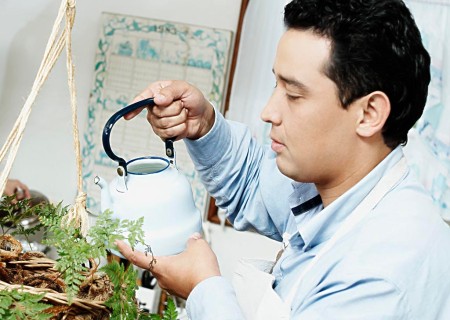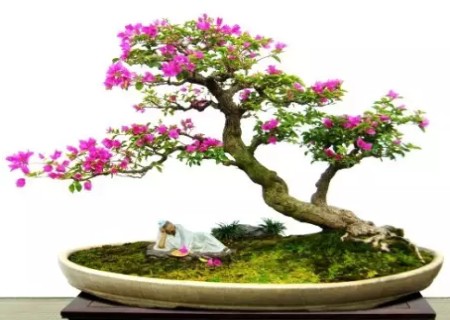How to trim triangular plum bonsai-trimming method of triangular plum bonsai
To the annual flowering season, the triangular plums dotted in the green leaves are burning like clusters of flames, like butterflies of different colors dancing, and the golden sun smears a layer of light gold on the petals, emitting the vitality of life. Triangular plum, also known as rhododendron, kudzu, extremely beautiful, can be made into single dry, oblique dry, double dry, Qugan, cliff and other different forms of potted plants.
Triangular plum, vigorous and elegant branches, colorful bracts, in full bloom, long viewing period, rich colors, strong germination, resistance to pruning, is an excellent tree species for bonsai production. Among them, the Lingnan school triangular plum bonsai is not mainly to watch the flowers, but to win with the skeleton of the branches, revealing its muscles and bones after picking leaves, vigorous atmosphere, and full of masculine beauty.

Triangular plum has strong germination, rapid growth and resistance to pruning, with pruning as the main shape and flat tie as the auxiliary. So, how to trim the triangular plum bonsai? First of all, let's take a look at the benefits of trimming triangular plum bonsai!
Benefits of pruning triangular plum bonsai:
1. The soil and nutrition of potted plants are limited, and the growth space is also limited, so it must be retracted to make potted plants maintain a certain size of plant type, so as to avoid falling behind in nutrition, poor plant growth and unbeautiful flowering.
2. People all want to make the potted flowers not only bloom more, but also want the flowering plant shape to look good. Pruning is to achieve the organic combination of potted flowers and bonsai, so that the potted flowers of triangular plum have a sense of bonsai, and the plant type can be appreciated at ordinary times.
3. Cut off the weak branches, withered branches and some useless branches, cut out the layers, so that the branches are exposed to light, so that the healthy and sturdy branches they need can get more nutrition, grow stronger, accumulate more nutrients, and bloom more beautifully.
Of course, there are many more reasons, so I won't repeat them here. This is only the first pruning, and we have to appreciate the pruning slowly during the growth process, and we have to pinch the buds and remove some unwanted buds and branches. If there are too many buds and too many branches and leaves, the nutrition of potted plants is always not enough.
Triangular plum is generally pruned after sprouting in spring, and can be often pruned at ordinary times, as long as the old and weak branches, withered branches, long branches and cross branches are cut off. After flowering, the pedicels are generally cut off, the branches of flower branches are retracted and the branches are thinned properly. Winter combined with basin soil pruning and so on.
Triangular plum is evergreen all the year round and needs to be pruned twice a year. Here are three common pruning methods.
1. Short-cut method
The short cut is to cut off part of the annual branch, the weighing short cut that cuts more (for example, cut off 1 pound 2 times 1 pound 3), the one that cuts less is called light short cut (such as cut off 1 pound 3 or less), and the middle one is called medium short cut. The characteristic of short shearing is that it has great irritation to the buds under the scissors, and the stimulation effect of the first bud under the scissors is the biggest, and the growth of the new shoots is the strongest, and the farther away from the scissors is, the smaller the stimulating effect is. The sprouting ability and branch forming ability of the branches after short pruning were improved, and the effect of medium and short shearing was the best. The short shearing can weaken the thickening of the mother branch.
2. Thinning and cutting method
Thinning pruning is to remove annual or perennial branches from the base. Thinning can weaken the growth potential of the upper branch, but promote the sprouting, branch formation and growth of the lower bud and branch. When the weak branches were removed, the above effects were not obvious in the pruning part, but they still promoted the growth of the whole tree as a whole. Thinning and pruning can reduce the shoot density, improve the light in the crown and promote the growth.
3. Shearing method
Shrunk refers to the pruning of perennial branches. The characteristic of shearing is that it promotes the growth of branches and the germination of latent buds at the back of the cut, while weakens the mother branches. Shearing is often used for the renewal and rejuvenation of old trees. The application of shearing should also follow the principle of gradual and orderly progress. If the size of the branch that needs to be shrunk is large, it should be shrunk several times.
In order to make it easier for netizens to understand, here are some pictures of pruning branches so that you can have an intuitive impression.
After the branch is cut, the wound left behind is called the cut, and the bud closest to the cut is called the cut bud. Pruning of trimmed plum should also grasp the three principles of short and heavy thinning, that is, cutting short horizontal branches, re-pruning new branches and thinning dense branches (weak branches).
Downward branches, vertical branches, and cross branches need to be removed. Located at about 5 mm above the shearing bud, it is horizontal. The flat shearing surface is small and easy to heal. It is commonly used in short twigs.
The triangular plum branch is cut obliquely and cut upward from the opposite side of the cut bud. Cut obliquely into an oblique plane of 45 °, making it slightly higher than the bud tip by about 5 mm. The lowest part of the slope is flat with the base of the bud. In this state, the wound is not too large, it is easy to heal, and the cut buds grow better.
If there are two parallel branches, it is necessary to remove the weaker branch, that is, to remove the weak branch.
After the branch is cut, the wound left behind is called the cut, and the bud closest to the cut is called the cut bud. Pruning of trimmed plum should also grasp the three principles of short and heavy thinning, that is, cutting short horizontal branches, re-pruning new branches and thinning dense branches (weak branches). The following describes some of the most basic pruning methods:
1. Heavy cutting: the branches are basically cut off, leaving the tree stump and several major branches, and the remaining major branches should also be cut very short. In particular, the branches that are not needed and those that destroy the plant type should be completely cut off. Re-cutting is generally used when the shape is changed.
2. Medium shearing: the specific gravity shearing should be lighter, only cutting off some dead branches and unnecessary branches, and the branches with good growth position will only be shortened, and the whole tree shape will not change too much. Medium scissors are generally used on shaped bonsai.
3. Light pruning: just cut short some weak branches, cut off diseased branches, cut healthy branches slightly, generally use them in seedlings, seedlings and young trees, and try to preserve more branches to form a strong tree potential, so as to facilitate photosynthesis and make the seedlings grow fast.
4. Retract: cut all the branches short so that the shape of this year's tree is about the same as that of last spring, so as to make room for the plant to grow and blossom, make the new branches stronger and bloom more beautiful and spectacular.
Warm reminder:
Triangular plum pruning should be moderate, can be the organic combination of the above four methods for pruning, do not cut too frequently, otherwise triangular plum bonsai will not be appreciated, according to the size of the flowerpot to determine the pruning weight of triangular plum, if it is not potted, it can be pruned according to the owner's own ideas.
Time: 2019-06-10 Click:
- Prev

How to water bonsai-watering method of bonsai
The most complicated step to take care of the bonsai is to water it properly. The frequency of watering trees depends on several factors, such as tree species, tree size, flowerpot size, season, soil composition and climate. Therefore, it is basically impossible to point out the correct frequency. However, after understanding the following basic guidelines
- Next

Trimming process of triangular plum bonsai (trimmed picture)
People all want to make the potted flowers not only bloom more, but also want the flowering plant type to look good. Pruning is to achieve the organic combination of potted flowers and bonsai, making the potted flowers of triangular plum a little bonsai meaning, usually you can appreciate the plant type. The editor is going to talk about how to prune potted triangular plums today. The growth period of Prunus mume is long and the growth rate is fast.
Related
- Fuxing push coffee new agricultural production and marketing class: lack of small-scale processing plants
- Jujube rice field leisure farm deep ploughing Yilan for five years to create a space for organic food and play
- Nongyu Farm-A trial of organic papaya for brave women with advanced technology
- Four points for attention in the prevention and control of diseases and insect pests of edible fungi
- How to add nutrient solution to Edible Fungi
- Is there any good way to control edible fungus mites?
- Open Inoculation Technology of Edible Fungi
- Is there any clever way to use fertilizer for edible fungus in winter?
- What agents are used to kill the pathogens of edible fungi in the mushroom shed?
- Rapid drying of Edible Fungi

